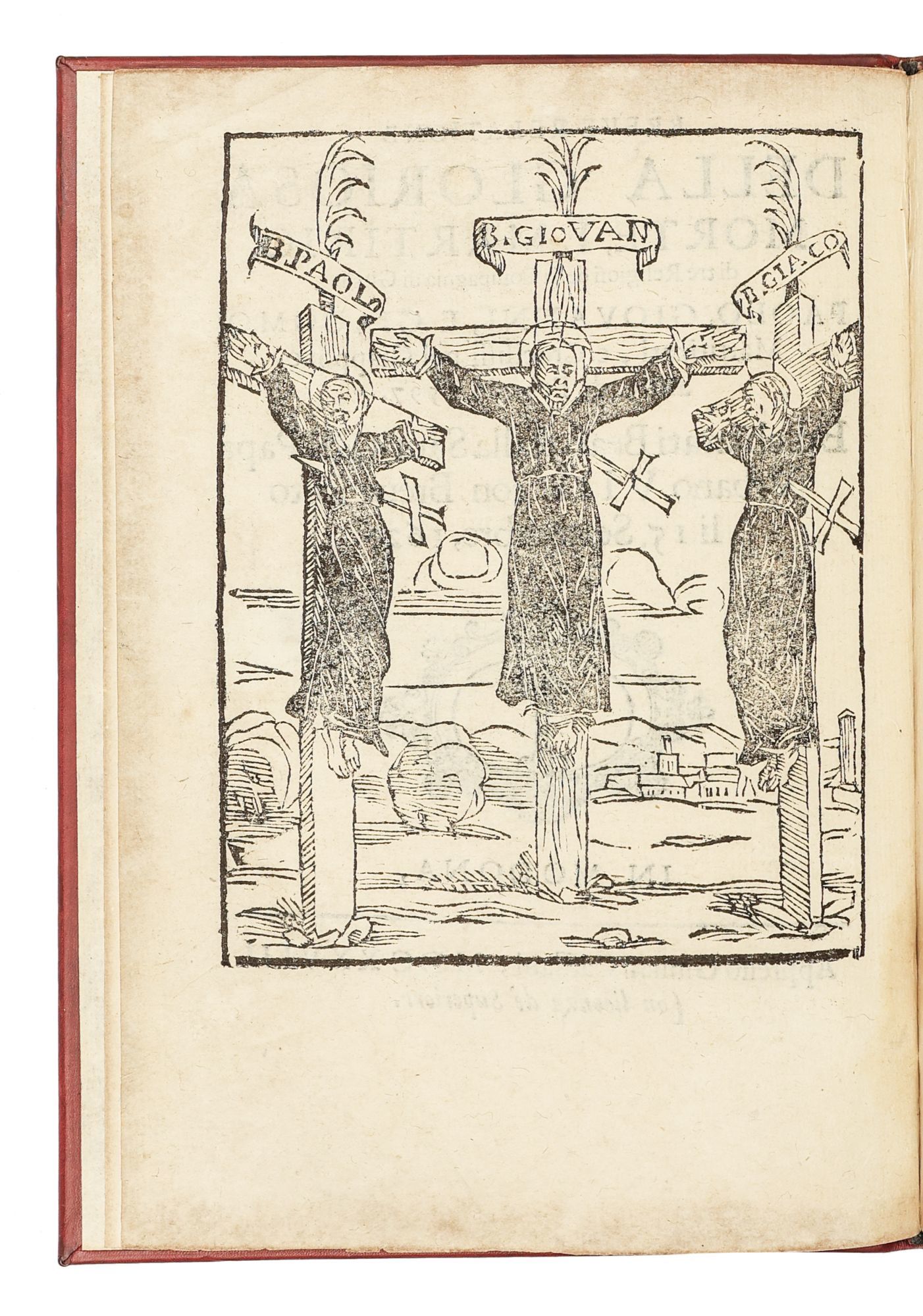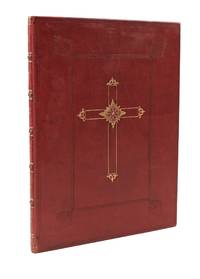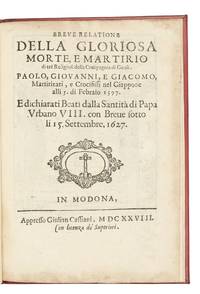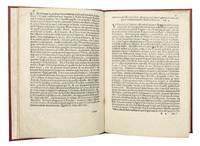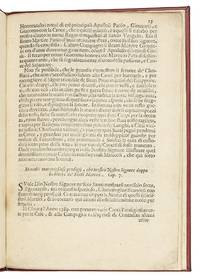Breve relatione della gloriosa morte e martirio di trè religiosi della Compagnia di Giesù: Paolo, Giovanni, e Giacomo, martirizati, e crocifessi nel Giappone alli 5. di Febraio 1597. E dichiarati Beati dalla Santita di Papa Urbano VIII. con Breve sotto li 15. Settembre, 1627
- SIGNED Hardcover
- Modena: Giulian Cassiani, 1628
Modena: Giulian Cassiani, 1628. SOLE EDITION THUS. Hardcover. Fine. Bound in modern paneled calf, the upper board embellished with gilt cross. Edges of title lightly browned. With a woodcut of the three crucified martyrs on the verso of the title page. 1 copy traced in North America (Newberry). A rare account of the suffering and martyrdom of the three young Japanese Jesuits: Paul Miki (b. 1564), James Kisai (1533), and João de Goto (b. 1578), who were crucified at Nagasaki on February 5, 1597. The text is based on the contemporary report of Pedro Gómez, Vice-Provincial of Japan from 1590 to 1600, who gathered eyewitness testimony from Nagasaki soon after the executions took place.
Gómez sent his account of the three men’s ordeal and glorious martyrdom to his superiors in Macau in early 1600. This particular version, which concludes with a description of the miracles and prodigies associated with the men after their death, was published on the occasion of their beatification (15 September, 1627), a crucial step toward sainthood. Publications such as this were often produced after beatifications in order to advance their subjects’ canonization.
The woodcut on the verso of the title page shows the three men crucified, with swords projecting from their bodies. This detail is at odds with the written account, in which Gómez tells us that they were run through by two spears, one from each side, in such a manner that the points met within the breast and came out opposite, forming a cross. However, the woodcut artist has given the swords pronounced hilts, which do give the swords a cruciform appearance.
Cordier lists six editions of Gómez’ account (or versions derived from his account), all now very rare. This Modena is apparently the only edition with an illustration. Cordier’s list includes editions in Latin, Italian, and French, all published in 1628. A German-language edition was printed at Mainz and another Italian ed. appeared at Rome in the same year. However, a comparison of our text with one of the other Italian editions shows that this is a different version, possibly produced by the publisher. The other editions examined do not report the miracles. More research remains to be done.
Twenty-six Christians were crucified in Japan on February 5, 1597, during the persecution of Christians by the second “great unifier” of Japan, Toyotomi Hideyoshi (1536/7-1598). The event was precipitated by an event in October 1596. A Spanish ship, the St. Filipe, had been shipwrecked on the island of Shikoku and the Spaniards intimated that the Christian missionaries were in Japan in preparation for a Spanish invasion. This enraged Hideyoshi, who ordered the arrest of certain priests and Japanese adherents. After an arduous, thousand-kilometer forced march from Kyoto to Nagasaki, those arrested were crucified. Among those martyred were three young Japanese boys, ages 12, 13, and 15; the Mexican chorister Felipe de Jesús, and three Japanese Jesuits.
The three Jesuits were Paul Miki (b. 1564), James Kisai (1533), and João de Goto (b. 1578). Miki, born into a wealthy Japanese family, was brought up as a Christian. He received a Jesuit education at Azuchi and Takatsuki, became a renowned preacher, and converted many Japanese to Christianity. He was an irmao, a Jesuit brother, not yet ordained, at the time of his death. João de Goto, a dojuku (a novice monastic), lived as one of the “hidden Christians” (kakure kirishitan) on the island of his birth; he later studied with the Jesuits at Nagasaki and Shiki. He was only 19 when he was crucified. By far the eldest of the three, James Kisai was raised a Buddhist but converted in adulthood, divorcing his wife, who remained Buddhism. He began his novitiate in 1594 at the age of 63.
Two of the miracles that followed these martyrdoms:
We are told that two months after the men’s execution, fresh, warm blood flowed from the metal clamps that had held them to their crosses. We are also told that -to the amazement of all- the crows that would normally have picked clean the corpses as they hung on the crosses, did not touch the flesh of the three martyrs but rather circled around them.
Other editions of Gómez’ text: Historia mortis trium Martyrum (Rome, Zannetti, 1628); Breve relatione della gloriosa morte di Paolo Michi, Giovanni Goto, e Giacomo Ghisai (Rome: Zanetti, 1628) Breve Ragguaglio del glorioso martyrio…. (Milan: 1628), Breve relatione della gloriosa morte…(Milan: 1628), Breve Racconto della Vita (Bologna: 1628), Briefve relation de la mort glorieuse (Louvain: 1628), (another ed. of same at Mons: 1628), Kurtzer Jnhalt vnd Begriff Deß glorwürdigen vnd sigreichen Todts welchen in Japonia (Mainz: 1628).
Gómez sent his account of the three men’s ordeal and glorious martyrdom to his superiors in Macau in early 1600. This particular version, which concludes with a description of the miracles and prodigies associated with the men after their death, was published on the occasion of their beatification (15 September, 1627), a crucial step toward sainthood. Publications such as this were often produced after beatifications in order to advance their subjects’ canonization.
The woodcut on the verso of the title page shows the three men crucified, with swords projecting from their bodies. This detail is at odds with the written account, in which Gómez tells us that they were run through by two spears, one from each side, in such a manner that the points met within the breast and came out opposite, forming a cross. However, the woodcut artist has given the swords pronounced hilts, which do give the swords a cruciform appearance.
Cordier lists six editions of Gómez’ account (or versions derived from his account), all now very rare. This Modena is apparently the only edition with an illustration. Cordier’s list includes editions in Latin, Italian, and French, all published in 1628. A German-language edition was printed at Mainz and another Italian ed. appeared at Rome in the same year. However, a comparison of our text with one of the other Italian editions shows that this is a different version, possibly produced by the publisher. The other editions examined do not report the miracles. More research remains to be done.
Twenty-six Christians were crucified in Japan on February 5, 1597, during the persecution of Christians by the second “great unifier” of Japan, Toyotomi Hideyoshi (1536/7-1598). The event was precipitated by an event in October 1596. A Spanish ship, the St. Filipe, had been shipwrecked on the island of Shikoku and the Spaniards intimated that the Christian missionaries were in Japan in preparation for a Spanish invasion. This enraged Hideyoshi, who ordered the arrest of certain priests and Japanese adherents. After an arduous, thousand-kilometer forced march from Kyoto to Nagasaki, those arrested were crucified. Among those martyred were three young Japanese boys, ages 12, 13, and 15; the Mexican chorister Felipe de Jesús, and three Japanese Jesuits.
The three Jesuits were Paul Miki (b. 1564), James Kisai (1533), and João de Goto (b. 1578). Miki, born into a wealthy Japanese family, was brought up as a Christian. He received a Jesuit education at Azuchi and Takatsuki, became a renowned preacher, and converted many Japanese to Christianity. He was an irmao, a Jesuit brother, not yet ordained, at the time of his death. João de Goto, a dojuku (a novice monastic), lived as one of the “hidden Christians” (kakure kirishitan) on the island of his birth; he later studied with the Jesuits at Nagasaki and Shiki. He was only 19 when he was crucified. By far the eldest of the three, James Kisai was raised a Buddhist but converted in adulthood, divorcing his wife, who remained Buddhism. He began his novitiate in 1594 at the age of 63.
Two of the miracles that followed these martyrdoms:
We are told that two months after the men’s execution, fresh, warm blood flowed from the metal clamps that had held them to their crosses. We are also told that -to the amazement of all- the crows that would normally have picked clean the corpses as they hung on the crosses, did not touch the flesh of the three martyrs but rather circled around them.
Other editions of Gómez’ text: Historia mortis trium Martyrum (Rome, Zannetti, 1628); Breve relatione della gloriosa morte di Paolo Michi, Giovanni Goto, e Giacomo Ghisai (Rome: Zanetti, 1628) Breve Ragguaglio del glorioso martyrio…. (Milan: 1628), Breve relatione della gloriosa morte…(Milan: 1628), Breve Racconto della Vita (Bologna: 1628), Briefve relation de la mort glorieuse (Louvain: 1628), (another ed. of same at Mons: 1628), Kurtzer Jnhalt vnd Begriff Deß glorwürdigen vnd sigreichen Todts welchen in Japonia (Mainz: 1628).


